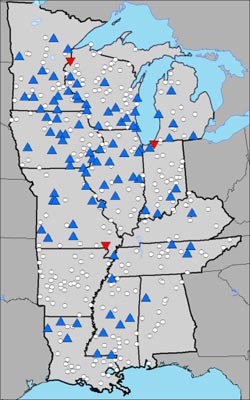Hard rain – UI study of Midwest finds increase in heavy rainfalls over 60 years

The map shows location of selected rain gauges, with blue (red) triangles depicting sites with significant increasing (decreasing) trends, and white circles showing sites with little or no change. Adapted from Villarini et al., 2013.<br>
The fact that temperatures over the country's midsection are rising, too, may be more than coincidence.The hotter the surface temperature, which has been the trend in the Midwest and the rest of the world, the more water that can be absorbed by the atmosphere.
And the more water available for precipitation means a greater chance for heavy rains, explains Gabriele Villarini, assistant professor in engineering at the UI and lead author of the paper, published in the Journal of Climate, the official publication of the American Meteorological Society.
“We found that there is a tendency toward increasing trends in heavy rainfall in the northern part of the study region, roughly the upper Mississippi River basin,” says Villarini, in the civil and environmental engineering department and an assistant research engineer at the IIHR-Hydroscience and Engineering. “We tried to explain these results in light of changes in temperature. We found that the northern part of the study region—including Minnesota, Wisconsin, Iowa, and Illinois—is also the area experiencing large increasing trends in temperature, resulting in an increase in atmospheric water vapor.“
Villarini notes the current drought affecting the Midwest and other regions of the country has occurred too recently to be included in his study, whose data goes from about 1950 to 2010.
“I’m not looking at the average annual rainfall. I’m studying heavy rainfall events,” he says. “We may currently be in deficit for overall rainfall, but we may also be in the normal range when it comes to the number of heavy rainfall days.”
Villarini and his colleagues examined changes in the frequency of heavy rainfall through daily measurements at 447 rain gauge stations in the central and southern United States. The states included were: Minnesota, Wisconsin Michigan, Iowa, Illinois, Indiana, Missouri, Kentucky, Tennessee, Arkansas, Louisiana, Alabama, and Mississippi.
Each rain gauge station has a record of at least 50 years. The data cover much of the 20th century and the first decade of this century. For the purposes of the study, heavy rainfall was defined as days in which rainfall exceeded the 95th percentile of the at-site rainfall distribution.
Villarini notes that while his study focused on changes in temperature and the frequency of heavy rainfall over the central United States, other published results have shown rainfall increases to be linked to changes in irrigation over the Ogallala Aquifer, which runs from Nebraska to northern Texas. Based on those studies, he says it is reasonable to assume that changes in land use, land cover and agricultural practice would affect the amount of water vapor in the atmosphere as well.
His colleagues in the study are James Smith, professor at Princeton University; and Gabriel Vecchi, of the National Oceanic and Atmospheric Administration.
The paper is titled, “Changing Frequency of Heavy Rainfall over the Central United States.” It was first published in January.
The research was funded by NASA and the Willis Research Network.
Contacts
Gabriele Villarini, Engineering, 319-384-0596
Gary Galuzzo, University Communication and Marketing, 319-384-0009
Media Contact
More Information:
http://www.uiowa.eduAll latest news from the category: Earth Sciences
Earth Sciences (also referred to as Geosciences), which deals with basic issues surrounding our planet, plays a vital role in the area of energy and raw materials supply.
Earth Sciences comprises subjects such as geology, geography, geological informatics, paleontology, mineralogy, petrography, crystallography, geophysics, geodesy, glaciology, cartography, photogrammetry, meteorology and seismology, early-warning systems, earthquake research and polar research.
Newest articles

Superradiant atoms could push the boundaries of how precisely time can be measured
Superradiant atoms can help us measure time more precisely than ever. In a new study, researchers from the University of Copenhagen present a new method for measuring the time interval,…

Ion thermoelectric conversion devices for near room temperature
The electrode sheet of the thermoelectric device consists of ionic hydrogel, which is sandwiched between the electrodes to form, and the Prussian blue on the electrode undergoes a redox reaction…

Zap Energy achieves 37-million-degree temperatures in a compact device
New publication reports record electron temperatures for a small-scale, sheared-flow-stabilized Z-pinch fusion device. In the nine decades since humans first produced fusion reactions, only a few fusion technologies have demonstrated…





















